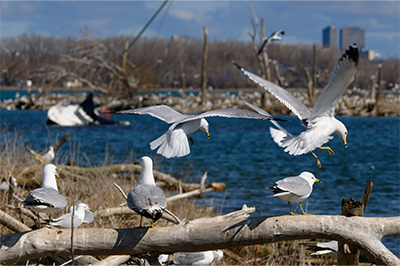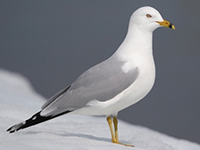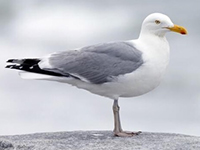
Wild Goose Chase (WGC) is an environmental services company that helps properties manage nuisance bird issues through science-based, ecological solutions. Below are Frequently Asked Questions (FAQs) pertaining to the Gull Egg Depredation service.
What is the ED service & how will it help manage gulls on my property?
During an ED service, WGC service technicians will systematically search for and remove any and all gull eggs observed on your property. By managing nest activity and removing eggs on a consistent basis, we will reduce the overall number of gulls on your property – which is foundational to lasting nuisance gull deterrence. Once gull nests are managed, your property will be able to reduce both property and asset damage from gulls and potential negative interactions between people and gulls.
What kinds of issues do gulls cause?
Gulls cause a number of issues on properties related to:
- Human Health & Safety: Droppings, feathers and nesting debris can create unsanitary conditions. Nesting gulls aggressively defend their nest, eggs and young by dive-bombing, defecating and/or vomiting on anyone who they perceive as a threat.
- Property & Asset Damage: The accumulation of droppings, feathers and nesting debris can clog air ducts, air return filters and roof drains
- Ambiance: gulls are loud, raucous birds and their droppings, feathers and nesting debris can create an unsightly mess
What species of gulls does WGC manage & how do they differ?
WGC manages two species of gulls: ring-billed and herring.
| Ring-billed Gull | Physical Description | Colony Description | Temperament | Incubation Period |
|---|---|---|---|---|
 |
A gray back, gray wings with black tips, distinguished by yellow-green legs and a black band around their yellow bill; physically smaller. | Tend to form large colonies, with several hundreds or even thousands of birds. | As the young, flightless chicks explore the world from the ground, their parents will continue to defend them from any perceived threat that ventures too close. | Their eggs are incubated for 20-31 days after which time the chicks hatch. Ring-billed gull chicks will leave the nest after just a few days but remain flightless for about 6 weeks. |
| Herring Gull | Physical Description | Colony Description | Temperament | Incubation Period |
|---|---|---|---|---|
 |
A gray back, gray wings with black tips, distinguished by pink feet and a red spot near the tip of their lower bill; physically larger. | Typically form smaller colonies. | Tend to be more aggressive when defending their nests, eggs, and young. | Longer incubation period, typically lasting 31-32 days and newly hatched chicks remain near the nest for up to 50 days after hatching. |
How do I know if ED service is right for my property?
If your property has a history of nesting gulls, ED services are highly recommended. Adult gulls have natal and site fidelity, meaning they prefer to nest on the property where they were born (natal) and/or the property on which they’ve previously successfully nested (site).
When are ED services provided?
ED services typically begin around mid-April and continue through mid-July.
How do I know if gulls are nesting on my property?
During nesting season, gulls congregate in colonies, sometimes several hundred strong. Gulls exhibiting nesting behavior are often:
- Seen in larger numbers (e.g., colonies)
- Loud, displaying long and warning calls
- Aggressive or territorial
- Leave evidence of nesting (e.g., materials, eggs)
Where can gulls nest?
As gulls typically prefer to nest on elevated surfaces that provide a good line of sight to spot approaching threats, rooftops are a common nesting location.
Is permitting required for ED services?
Yes. Both ring-billed and herring gulls are federally protected species, meaning a permit must be obtained in order to handle adult gulls and their nests and eggs. The permitting process varies by state and can involve permits from both federal and state regulatory authorities.
How long does it take to obtain the necessary permits?
Permit processing times typically range from 8 to 10 weeks. Given the length of time it takes to obtain the necessary permits from all relevant regulatory agencies, WGC recommends beginning the permitting process no later than January.
Can WGC help my property obtain the necessary permits?
Yes. Part of the permitting process includes determining a limit on the number of gull nests that can be taken from a single property. As part of our ED service, WGC will work closely with your property and relevant regulatory agencies to determine the appropriate number of gull nests and eggs that must be removed.
Should additional gull nests and eggs need to be removed beyond the determined limit, WGC can submit an amendment to the permit application. At the end of the nesting season, WGC will compile the necessary data into a report, and submit it to the relevant state and federal authorities.
I found a nest on my property but don’t have a permit. What can I do?
Your options depend on the status of the nest:
- Inactive (e.g., there are no eggs present): you may destroy or dispose of the nest without a permit
- Active (e.g., there are eggs): federal law prohibits you from disturbing the nest without obtaining the necessary permits
- Young (e.g., eggs have hatched): neither you nor WGC may remove the nest; the gulls will have to leave on their own (typically August)
Be advised: gulls may still want to defend a nest even without eggs or young in it. Therefore, consult WGC on best practices.
Gulls on my property are becoming aggressive. What do I do?
Gulls will defend their nests, eggs and young during the nesting season, when their eggs and young are most vulnerable. Below are a few best practices to minimize negative interactions with nesting gulls:
- Do not feed, approach or attempt to interact with gulls, nests or their young
- If you are able to, cordon off the area or leave a sign informing people of the presence of the gulls, preferably away from the nest so people have enough space and time to find an alternate route
- If you are approached by a gull, it is best to put your hands on your head and crouch low
How do I prevent gulls from nesting on my property?
When it comes to preventing gulls from nesting on your property, having a plan in place before spring is essential for successful management. Below is the recommended sequence of management techniques:
1. Gull ED Service
If your property experienced gull nesting last year or in previous years, there is a high likelihood gulls will return. In these instances, WGC first recommends that an ED service be undertaken to reduce year-over-year colony population growth.
2. Gull Harassment
After a successful ED service, deploying a harassment tool ahead of the next gull nesting season can effectively dissuade gulls from nesting at that location. Whichever harassment tool is deployed, it needs to be in place well ahead of when gulls typically return (April). Harassment tools include, but are not limited to:
a. Visual deterrents, such as automated bird lasers
b. Structural deterrents, such as wire grid systems
c. Audio deterrents, such as sound makers


